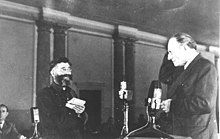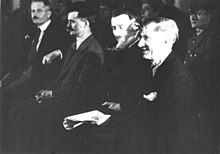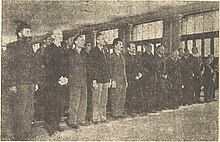Trial of Mihailović et al.

The Trial of Draža Mihailović et al., or the Belgrade Process (Serbo-Croatian: Београдски процес, romanized: Beogradski proces), was the 1946 trial of Draža Mihailović and a number of other prominent convicted collaborators for high treason and war crimes committed during World War II.
Mihailović was tried as a leader of the Chetnik movement during World War II (the "Yugoslav Army in the Fatherland", JVUO). His co-defendants were other prominent figures of the movement and members of the Yugoslav government-in-exile, such as Slobodan Jovanović, along with members of ZBOR and of the Nedić regime like Velibor Jonić.[1] The trial opened on June 10, 1946, before the Military Council of the Supreme Court of the Federal People’s Republic of Yugoslavia, and lasted until July 15, 1946. The trial opened in the presence of about 60 foreign journalists.[2] The court was located in the Summer Hall of the Infantry Training School at Topčider in Belgrade.
In 2015, a Serbian court rehabilitated Mihailović and overturned his conviction, ruling that it was the result of a communist political show trial that was fundamentally and inherently unfair.[3][4]
Indictment
[edit]The accused were tried before a military court. The President of the council was Mihailo Đordević and the members Milija Laković and Mihailo Janković, with Todor Popadić as secretary. The assistant judges were Nikola Stanković and Radomir Ilić. The prosecutor was Miloš Minić, a high-ranking government official who took part in Tito-Mihailović negotiations in 1941. The assistant prosecutor was Miloš Jovanović.
Mihailović and others were tried mainly for their activities against Allied forces, the Yugoslav Partisans, for collaboration with the Germans and for war crimes against civilians. Mihailović was indicted on 47 counts. He was found guilty of all charges and sentenced to death.[5]
The Allied airmen he had rescued in 1944 were not allowed to testify in his favor. Only two women came to testify in favor of Mihailović. Reportedly, they were heckled by the audience and, after the trial, submitted to a professional interdiction.[6] At the trial the witness that appeared were: Dušan Simović, Radoslav Đurić, Jovan Škavović, Miša Simović and Milan Grol.
Indictees
[edit]



The accused were, in the order their names were read out at the trial:
| No. | Indictee | Position | Defender(s) | Penalty[7] | Notes |
|---|---|---|---|---|---|
| 1 | Draža Mihailović | Leader of Chetnik movement | Nikola Đonović and Dragić Joksimović | Death | Executed on 17 July 1946 |
| 2 | Stevan Moljević | President of Executive board of Chetnik Central National Committee (CNK) | 20 years | Died in prison | |
| 3 | Mladen Žujović | Member of CNK Commander of Chetniks in Dalmatia, Lika and western Bosnia (1943-1945) |
Nikola Radovanović | Death (in absentia) | |
| 4 | Živko Topalović | Vice President of Executive board of CNK | 20 years (in absentia) | ||
| 5 | Đuro Vilović | Secretary of the Executive Board of CNK | Milan Omčikus | 7 years | |
| 6 | Rade Radić | Member of CNK Commander of Chetnik detachment Borja |
Lazar Vučetić | Death | Executed on 17 July 1946 |
| 7 | Slavoljub Vranješević | Chetnik commander of western Bosnia (1943-1945) | Blažo Radović | 20 years | |
| 8 | Miloš Glišić | Commander of Požega Chetnik Detachment and Sandžak Military Chetnik Detachment | Death | Executed on 17 July 1946 | |
| 9 | Slobodan Jovanović | Prime Minister in Yugoslav government-in-exile (YGE) (1942-1943) | Miloš Terzić | 20 years (in absentia) | |
| 10 | Božidar Purić | Prime Minister in YGE (1943-1944) | Pavle Miljaković | 16 years (in absentia) | |
| 11 | Momčilo Ninčić | Minister of Foreign Affairs in YGE (1941-1943) | David Alkalaj | 8 years (in absentia) | |
| 12 | Petar Živković | Minister without Portfolio in YGE (1943-1945) | Pavle Miljaković | Death (in absentia) | |
| 13 | Radoje Knežević | Minister of the Royal Court in YGE (1941-1943) | Slobodan Subotić | 10 years (in absentia) | |
| 14 | Milan Gavrilović | Minister of Justice, Agriculture, Supply and Food in YGE | 15 years (in absentia) | ||
| 15 | Živan Knežević | Military liaison officer between the Chetniks and government-in-exile | Dragutin Tasić | 20 years (in absentia) | |
| 16 | Konstantin Fotić | Ambassador to USA of government-in-exile | 20 years (in absentia) | ||
| 17 | Dragomir "Dragi" Jovanović | Nazi appointed Mayor of Belgrade Chief of State Security |
Slavko Dukanac | Death | Executed on 17 July 1946 |
| 18 | Tanasije Dinić | Deputy Commissar of Interior in Commissioner Government Minister of Interior (1942-1943) and Minister of Social Policy and Health (1943-1944) in Government of National Salvation |
Bogoljub Jovanović | Death | Executed on 17 July 1946 |
| 19 | Velibor Jonić | Commissar of Education in Commissioner Government Minister of Education in Government of National Salvation |
Milan Živadinović | Death | Executed on 17 July 1946 |
| 20 | Đura Dokić | Minister of Transportation in Government of National Salvation (1941-1942) | Dragoljub Joksimović | Death | Executed on 17 July 1946 |
| 21 | Kosta Mušicki | Commander of Serbian Volunteer Corps | Đorđe Ćirić | Death | Executed on 17 July 1946 |
| 22 | Boško Pavlović | Assistant to commander of Serbian State Guard and State undersecretary in Government of National Salvation | Slobodan Subotić | Death | Executed on 17 July 1946 |
| 23 | Laza Marković | Signator of Appeal to the Serbian Nation | Aleksandar Nikolić | 6 years | |
| 24 | Kosta Kumanudi | Signator of Appeal to the Serbian Nation | Friedrich Pops | 18 months |
Out of the twenty-four accused individuals mentioned above, ten were tried in absentia.
Foreign accreditation
[edit]Teams were sent by the agencies TASS, ČTK, PAP, Reuters, Associated Press, Agence France-Presse, United Press, Overseas News Agency, International News Service, the Jewish Telegraphic Agency, Tele Press, the Albanian Telegraphic Agency and the following newspapers: Pravda, Izvestia, The Times, the Daily Worker, The New York Times, the New York Herald Tribune, the News Chronicle, the Daily Express and others.
Verdict
[edit]
Mihailović is quoted as saying, in his final statement, "I wanted much; I began much; but the gale of the world carried away me and my work.".[8] "Gale of the world" is sometimes translated "Winds of War."
The verdict was read on 15 July 1946. Mihailović and ten others were sentenced to death by a firing squad (two in absentia).[7] An appeal was rejected on 16 July and the nine were executed on 17 July. The remaining defendants were sentenced to penalties ranging from 18 months to 20 years in prison.[7]
Reactions
[edit]In six days of questioning by the public prosecutor, Mihaylovitch admitted to guilt on practically all counts, although he appears to have done his best to shield behind a plea that he was a victim of circumstance and of the disobedience of his own commanders in the field.[2]
The trial showed, according to historian Jozo Tomasevich, that Mihailović had never possessed firm and full control over his local commanders.[9] A committee for the fair trial of General Mihailovic was set up in the United States, but to no avail.
Diplomat and author Walter Roberts stated that the trial was "anything but a model of justice" and that "it is clear that Mihailović was not guilty of all, or even many, of the charges brought against him" though Tito would probably not have had a fair trial either, had Mihailović prevailed.[10]
At the time of the trial, there were protests from the Americans and the French, although both were moderated by their interest in the new government.[11]
According to Mihailović biographer Jean-Christophe Buisson, one of Mihailović's lawyers, Dragić Joksimović, was arrested a few days after the execution and died in prison under unclear circumstances.[12]
Modern views
[edit]More recently, there have been calls[by whom?] for a retrial and/or rehabilitation. Momčilo Ninčić was officially rehabilitated in 2006 and Slobodan Jovanović in 2007 by Serbia.[13] In 2015, a Serbian court invalidated Mihailović's conviction. The court held that it had been a Communist political show trial that was controlled by the government. The court concluded that Mihailović had not received a fair trial. Mihailović was, therefore, fully rehabilitated.[14][15][16]
Proceedings
[edit]| Date | Event |
|---|---|
| 13 March | Mihailović is captured. |
| 24 March | Aleksandar Ranković announces the capture of Mihailović, as well as charges against him. |
| 2 April | The US State Department announces it has requested that American Army personnel be allowed to testify at the trial.[17] |
| 17 May | The trial is delayed to 10 June. |
| 10 June | The trial begins. |
| 15 July | Death sentence delivered to Mihailović. He is given eight and a half hours to appeal to the Yugoslav Presidency. |
| 16 July | Appeal is denied by the Presidency. |
| 17 July | Execution by firing squad is carried out. |
References
[edit]- ^ Jean-Christophe Buisson, Le Général Mihailovic : héros trahi par les Alliés 1893–1946, Perrin, Paris, 1999, page 262
- ^ a b "Basil Davidson: PARTISAN PICTURE". www.znaci.net. Retrieved 4 January 2019.
- ^ "69 years after execution, WWII general gets Nazi treason conviction tossed". www.cbsnews.com. 14 May 2015. Retrieved 4 January 2019.
- ^ "Serbia rehabilitates WWII royalist killed for collaborating with Nazis". Reuters. 14 May 2015. Retrieved 4 January 2019 – via www.reuters.com.
- ^ The trial of Dragoljub-Draža Mihailović stenographic record and documents from the trial of Dragoljub-Draža Mihailović.
- ^ Jean-Christophe Buisson, Le Général Mihailovic : héros trahi par les Alliés 1893–1946, Perrin, Paris, 1999, pp 260–263
- ^ a b c File:Presuda Drazi Mihailovicu i ostalima.pdf, Original convictions document
- ^ One Who Survived, Time, 7 October 1957
- ^ Jozo Tomasevich, The Chetniks: war and revolution in Yugoslavia, 1941–1945, Stanford University Press, 1999, pp 462–463
- ^ Walter R. Roberts, Tito, Mihailović and the Allies 1941–1945, Rutgers University Press, page 307
- ^ Martin, David. Patriot or Traitor: The Case of General Mihailović: Proceedings and Report of the Commission of Inquiry of the Committee for a Fair Trial for Draja Mihailović. Hoover Archival Documentaries. Hoover Institution Publication, volume 191. Stanford, CA: Hoover Institution Press, Stanford University, 1978.
- ^ Jean-Christophe Buisson, Le Général Mihailovic : héros trahi par les Alliés 1893–1946, Perrin, Paris, 1999, page 271
- ^ "Rehabilitacija Slobodana Jovanovića". Nedeljnik Vreme. November 2007. Retrieved 4 January 2019.
- ^ "Court rehabilitates WW2-era Chetnik leader Draza Mihailovic - English - on B92.net". B92.net. 14 May 2015. Retrieved 4 January 2019.
- ^ "Serbia Rehabilitates WWII Chetnik Leader Mihailovic". www.balkaninsight.com. 14 May 2015. Retrieved 4 January 2019.
- ^ "Draza Mihailovic rehabilitated", May 14, 2015, InSerbia.
- ^ U.S. Defends Mihailovic in Note to Yugoslavs, The Milwaukee Sentinel – Apr 3, 1946.
Further reading
[edit]- Marcia Christoff Kurapovna (2010). Shadows on the mountain: the Allies, the Resistance, and the rivalries that doomed WWII Yugoslavia. John Wiley and Sons. ISBN 978-0-470-08456-4. chapter 10
External links
[edit]- Filmske Novosti documentary with some photos[dead link]
- PDF files of some original documents from the trial
- Miodrag Zečević: DOKUMENTA SA SUÐENJA DRAŽI MIHAILOVIĆU – PDF files of original documents from the trial in serbocroatian
- IZDAJNIK I RATNI ZLOČINAC DRAŽA MIHAILOVIĆ PRED SUDOM – stenographic notes from the trial in serbocroatian
- DOKUMENTI O IZDAJSTVU DRAŽE MIHAILOVIĆA – book of documents of the yugoslav State commission for investigating war crimes on Mihailović
